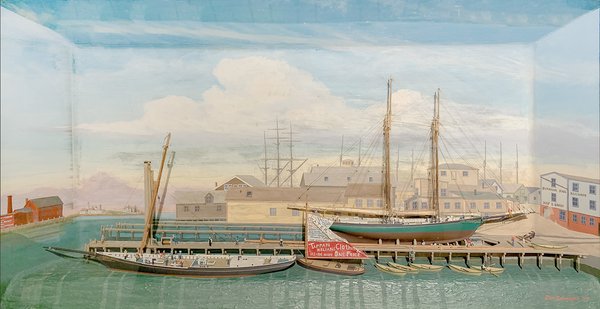Hauling-out and Mast Stepping
Hauling-out and Mast Stepping
This view focuses on vessel activity at Burnham Brothers Marine Railway in Gloucester’s Inner Harbor, looking southwest from Ayer’s Wharf. Beyond the railway and its buildings are residences which occupied Duncan’s Point. One well-known resident was artist Fitz Henry Lane whose house still stands and whose depiction of this railway is on exhibit in the Museum’s Cape Ann Gallery, together with a large diorama which also includes a marine railway.
Depicted here in model form are the fishing schooner “Rose Cabral” hauled out for routine maintenance, the fishing schooner “Arthur Binney” at pierside having her fore mast stepped, and the water boat “Aqua Pura” awaiting a request to supply an outbound fishing schooner with fresh water. The advertising on “Aqua Pura”s was copied from a photograph. Astern of her are “Rose Cabral”s dories, which will go back on deck when the schooner returns to the water.
Vessels could be hauled out for numerous types of repairs. Scraping the bottom and a fresh coat of copper (antifouling) paint was routine for all vessels – as depicted here. More serious repairs for rot, teredo worm damage, or collision damage could result in a lengthy hauling-out at considerable expense. That said, marine railways were a more economical alternative to dry docks, both in costs of building and operating.
While depictions and photographs of marine railways are common, the stepping of a vessel’s mast, using the stepping crane, has rarely been depicted. The opportunity to show this process in three dimensions played an important part in the composition of this work, while making it a useful adjunct to other depictions of harbor activity.
Details
| Artist: | Erik A.R. Ronnberg, Jr. |
|---|---|
| Date of work: | 1997 |
| Medium: | Wood, paint, metal, cordage |
| Accession number: | 2021.044 |
| Credit line: | Gift of Larry Costa, 2021 |

